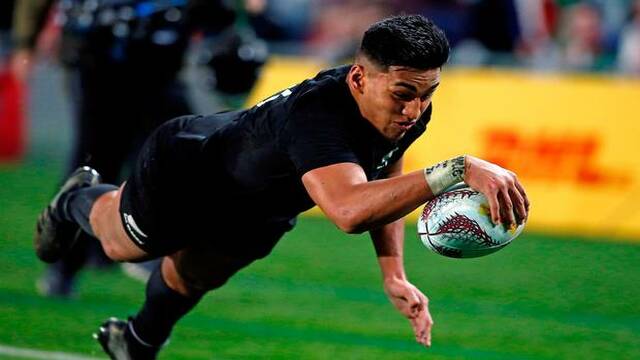How the All Blacks sidestepped the Lions rush defence in the first Test
One of the great questions in the build-up to the Test series between New Zealand and the British & Irish Lions was: How will the All Blacks attack the Lions’ rush defence? – masterminded by Ireland defence coach Andy Farrell.
That defence had some notable successes in three of the four matches leading into the game at Eden Park, conceding only one try in three games against the Maori All Blacks, the Crusaders and the Chiefs. That sole try was also the result of an individual error rather than a breakdown in the system itself.
During the first half of the tour, the Lions’ opponents did not have much success with the variations of the short attacking kicking game I explored in these two articles:
Unlock the press defence part 2, despite persistent efforts on their part.
The All Blacks’ brains trust, mindful of the pressure the Lions were able to bring when the ball was spun beyond first receiver, chose instead to take on the tourists where they believed they were strongest – in the very physical area patrolled by the first three defenders nearest the edge of the breakdown.
They played primarily off their #9 Aaron Smith in those short channels, and when they moved the ball as far as #10 Beauden Barrett, the play of choice was more often than not a switch or inside pass.
Another crucial element of their success was the willingness to introduce an outstanding aspect of their attacking game, the offload, into a scenario where they do not typically use it. Usually the All Blacks only offload in the wide channels or after a line-break, but against the Lions they surprised their opponents by offloading in the heavy traffic close to the ruck.
So New Zealand decided to attack their opposition both in a place he did not expect, and in a way he could not have foreseen. This enabled the All Blacks to control the football, and build almost twice as many rucks in the course of the game than the Lions (131 to 76).
Let’s take a look at one of the early examples through which New Zealand developed their momentum. It comes from an attacking scrum in midfield and the sequence has been divided into two parts.
First phase flags up the All Blacks’ ultimate intention. With Owen Farrell hard up on Barrett at first receiver, and the next key defender (#13 Jonathan Davies in the grey hat) ready to press up on Ryan Crotty outside him, Barrett releases Sonny-Bill Williams on a switch underneath the rush. And Sonny-Bill does not die with the ball, he offloads it instead to Crotty, who has come down short in support.
On the next phase, the screenshot at 6:29 is a telling one:

All fifteen All Blacks are condensed into one half of the field, and the two wide forwards who would typically be playing in the near 15 metre zone (#6 Jerome Kaino and #2 Codie Taylor) are far further infield, close to the centre spot. The attacking focus is far narrower than normal for New Zealand, and the All Blacks have a local 5-on4 advantage as Barrett goes to make the in-pass to Kieran Read.
The same principles are at work on next phase after Read’s carry:
The All Black ball-carrier off 9 (#4 Brodie Retallick) once again chooses to cut back inside the pressure brought by the Lions’ hooker Jamie George:


Retallick’s inside move opens up some possibilities on the interior of the defence in the second frame. With George already on the wrong side of the ball, suddenly all of Aaron Smith (1), Sam Cane (2) and Joe Moody (3) are in play against one defender – the Lions’ play-side guard Tadgh Furlong. Looking at their eyes, they understand the opportunities presented very well.
As soon as Retallick manages to free up his right arm in the tackle, all of his support runners come alive:

The target area is exposed with both Furlong and George committed to tackling Retallick, the Lions’ defensive half-back Conor Murray on the far side of the ruck, and four All Black support runners flooding the zone.
In the event, Retallick picks out Smith in the hole with three other All Blacks still running in support:

Summary
The French general and master strategist, Napoleon Bonaparte, once said, “The art of war consists of always being able (even with an inferior army) to mobilize stronger forces than the enemy at the point of attack – at the local point of attack.”
The All Black policy against the Lions’ rush defence in the first Test at Eden Park certainly brought that maxim to life.
New Zealand concentrated their attacking resources rather than spreading them across the field as per their typical strategy, looking for the opportunity to gain a local advantage against the Lions’ defenders closest to the breakdown.
Once that advantage became manifest, they used their superior offloading abilities to exploit it and prevent the defence from resetting effectively. It was an object lesson in confounding expectation and playing ‘against pattern’ in order to achieve success.


